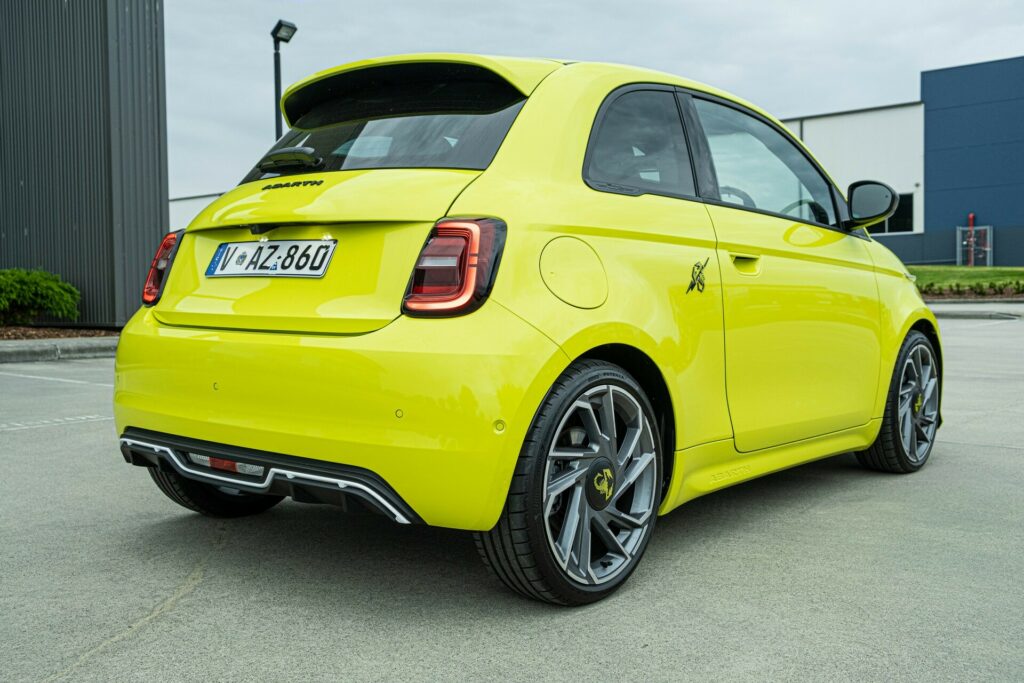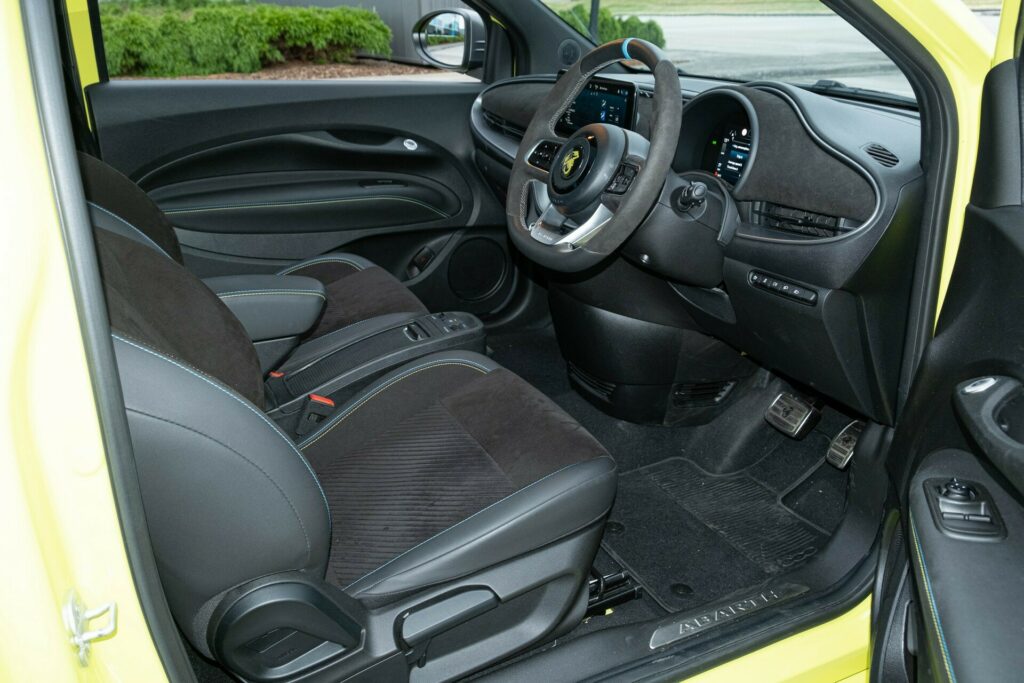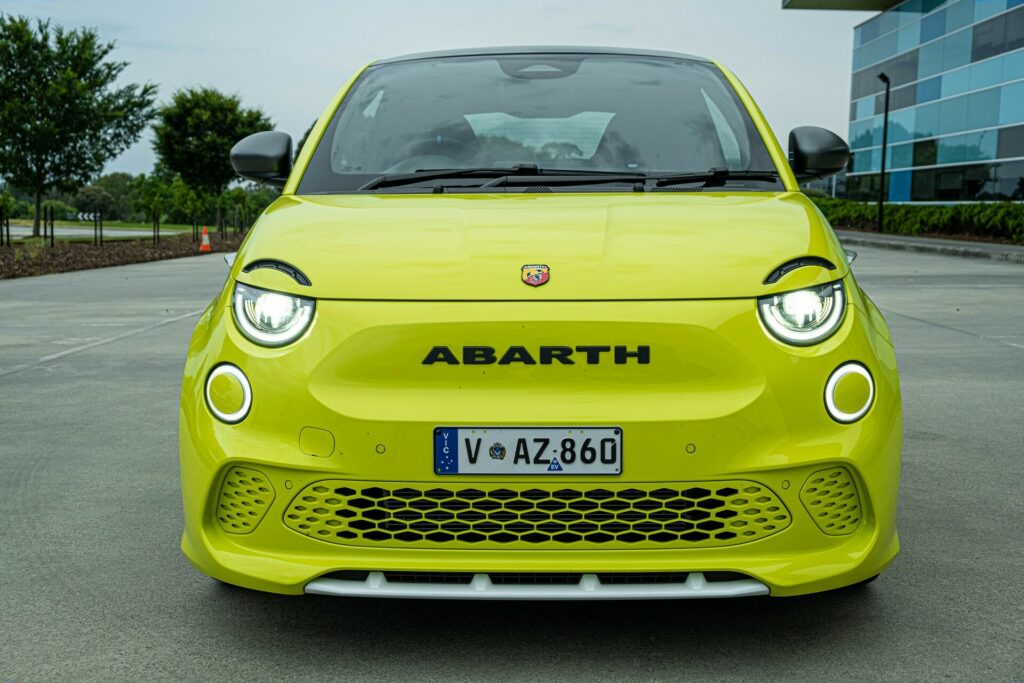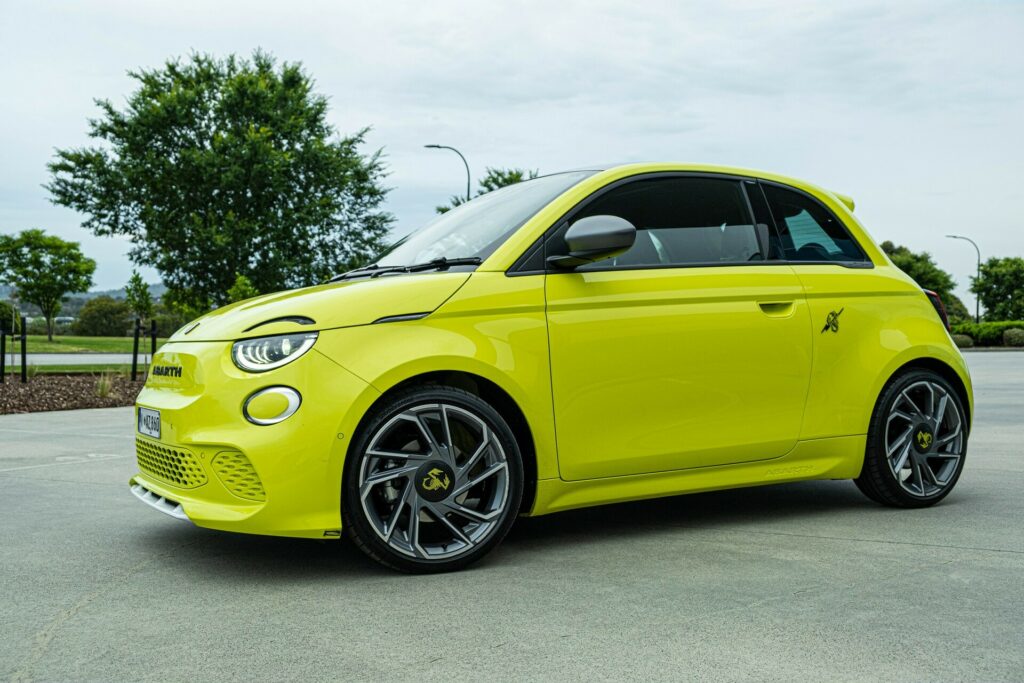The Abarth 500 series is one of the most recognizable sporty small cars launched in the past two decades. While it may lack the brute power of some larger hot hatches, its diminutive size and nimbleness have earned it a unique place in its class, making it a favorite for driving enthusiasts who value agility over outright speed.
The all-electric 500e retains much of the same charm as its internal combustion sibling. Although it carries additional weight due to its battery pack, it remains just as compact and maneuverable. However, the question looms: does it possess the right blend of performance and character to live up to its predecessors, or is it a misstep from Stellantis, the automotive juggernaut that’s fighting for survival in an ever-evolving market?
QUICK FACTS
A pricey proposal
It’s impossible to talk about the Abarth 500e without first discussing the price. In Australia, it starts at AU$58,900 (~$38,100) before on-road costs. Compared to the regular Fiat 500 La Prima that initially launched at AU$52,500 (~$33,900) but has since been reduced to AU$49,990 (~$32,300), that’s not bad value for money, given all of the upgrades made to the Abarth version.
However, the Abarth 500e doesn’t represent such good value for money when compared to other sporty EVs out there. For instance, the more practical MG 4 X Power, boasting 320 kW (429 hp), starts at AU$59,990 ($38,800). Similarly priced are the larger Cupra Born, also beginning at AU$59,990 ($38,800), and the Chinese Ora GT, which comes in at a more affordable AU$46,990 ($30,400).
Additionally, a range of bigger and roomier electric sedans and SUVs, such as the BYD Seal and Tesla Model Y, also start around the AU$60,000 ($38,800) mark. Considering the Abarth’s significantly smaller size compared to these alternatives, one might reasonably expect a lower price point.

Abarth continues to sell the combustion-powered 695 alongside the 500e and it too is much cheaper. In fact, it starts at AU$38,900 (~$25,100), all while packing more grunt than the EV, looking just as sporty and having the same tiny footprint. Has Abarth done anything to make the 500e feel worthy of its hefty price tag?
What changes have been made?
To start, Abarth has overhauled the exterior design and done a fine job of it. The front end has been tweaked to look much more aggressive than the standard model, and when painted in Acid Green like our test car, the 500e turns heads in a way that few other vehicles at this price point can. Providing some extra flair are 18-inch wheels, Scorpion badges on the rear quarter panels, and a beefy rear end that looks suitably sporty for a model with an Abarth badge.
Read: Abarth Is Done With ICE, Eyes A Larger Electric SUV
Then there’s the performance. Like the regular 500e, the Abarth is powered by a single electric motor driving the front wheels. However, whereas the standard model is capped at 87 kW (117 hp) and 220 Nm (162 lb-ft) of torque, the Abarth ups the ante with 114 kW (153 hp) and 235 Nm (173 lb-ft). Driving the front-mounted motor is a 42 kWh battery, and Abarth says the tiny hatch can hit 100 km/h (62 mph) in a respectable 7 seconds.
Photos Brad Anderson/Carscoops
A nicer but cramped cabin
Plenty of changes have been made to the interior, too. Unsurprisingly, it’s just as compact as the standard model but feels slightly more premium thanks to a slew of nicer materials. These include black Alcantara on the steering wheel and dashboard, bright blue and green contrast stitching, and prominent Abarth emblems on the steering wheel and pedals. A set of sports seats comes standard, and they, too, include a nice mix of Alcantara and leather.
Unfortunately, and much like the petrol-powered 695, the seats of the 500e are mounted way too high, resulting in an odd driving position for a sporty hatch like this. This also limits headroom, and at 6’2”, my hair would occasionally brush against the ceiling. It’s also a shame the Abarth has the same flimsy and wafer-thin sunshade for the glass roof as the standard model. It does a poor job of blocking the sun and an even poorer job of blocking unwanted heat from entering the cabin.
Despite the car’s compact size, storage is decent. There are reasonably spacious door pockets, a wireless phone charger, and a surprisingly deep center console. The lack of a tunnel between the front seats also adds to the practicality.

Found in the center of the dash is a 10.25-inch infotainment system that includes wireless and wired Apple CarPlay and Android Auto. However, wireless Android Auto proved troublesome during our week with the car. On more than a dozen occasions, the system unexpectedly disconnected from my phone while driving. It would quickly reconnect but after 10 or 15 minutes, would disconnect once again. It was more stable when using a USB-C cable, but it still dropped out a couple of times.
The 7-inch digital instrument cluster is nicer. It’s clear and crisp and offers a slew of different display settings.
The second row is tight and not suitable for adults. Even teenagers will struggle to get back there. We wouldn’t go as far as to say the rear seats are useless but they serve very little purpose other than to ferry small children around, something which we suspect few Abarth owners do. It’d be nice if Abarth offered an option to remove the rear seats, as it would help to make the compact trunk a little more practical.
A punchy performer
Driving the Abarth 500e in a host of different environments reveals plenty of perks, as well as a few faults. In a straight line, it is spritely enough that you have to brace your neck when accelerating or risk slamming your head into the headrest. Where the 500e shines, though, is in handling.
Photos Brad Anderson/Carscoops
Tipping the scales at 1,335 kg (2,943 lbs), it’s not exactly a featherweight given its size. However, the short wheelbase and low center of gravity make it feel like a circa 1,000 kg (2,200 lbs) car. The steering is light and direct, making the Abarth heaps of fun to toss in the turns. It does feel a little numb to steer, but that’s to be expected for the revised electric power steering.
The grip is superb. Aussie-delivered examples come standard with Bridgestone Potenza Sport tires, one of the better ultra high performance summer shoes on the market. The front end offers plenty of bite, and it’s easy to push the tires to the limit of adhesion without exceeding it. It feels like a ferocious French bulldog, clawing at the pavement and sprinting away on the corner exit. The brakes are also very impressive, even though they’re quite small.
Photos Brad Anderson/Carscoops
Efficiency is another one of the 500e’s strong suits. Abarth says the hatch can travel up to 253 km (157 miles) on a single charge, a decent figure when you consider it only has a 42 kWh pack. During our time with the key, which included several ~60 km (37 miles) jaunts, we averaged 13.3 kWh / 100 km, making it one of the more efficient EVs we’ve tested and almost matching the standard Fiat 500e.
Review: The Fiat 500e Review Is A Stylish EV But At What Cost?
A trio of driving modes are offered. For everyday driving, the Abarth is best left in Turismo mode, which slows the throttle response and turns on one-pedal driving. A Scorpion Street mode is also offered. It makes the hatch feel much more responsive while retaining the one-pedal mode. The fiercest mode is Scorpion Track, which feels very similar to Scorpion Street but significantly reduces the regenerative braking.

The overly firm ride was a bit of a letdown. As someone who daily drives a Renault Megane RS, a hot hatch known for having a firm ride, I’m used to some level of harshness on the road, but the Abarth 500e is noticeably stiffer, not only compared to my Megane RS but others at this price point. The positive of the suspension setup is that the car has very little roll while cornering.
Silly sounds
Engineers from Abarth spent over 6,000 hours developing a Sound System Generator for the 500e designed to replicate the sounds of its ICE-powered models. It is… interesting, to say the least.
The sound generated from the external speaker is quite organic and does a better job of replicating a combustion engine than the synthetic soundtrack used by the Hyundai Ioniq 5 N. However, it’s far from perfect, which makes me wonder just how hard those engineers were working during those 6,000 hours.

My biggest criticism of the system is immediately apparent when you start driving the 500e with the sound turned on. While accelerating, having a thumping soundtrack adds to the thrill of driving the car. However, once you hit the speed limit and start cruising, the speaker continues to pump out an exhaust note just as loud as when you’re accelerating. It’s as if you’re sitting at the top of 2nd gear in an ICE car and almost bumping into the rev limiter.
By comparison, the Ioniq 5 N’s fake sounds work in conjunction with the augmented eight-speed transmission, meaning you can manually go into ‘8th gear’ and limit the sounds. The Hyundai also offers 20 different levels of sound output, whereas the Abarth only has one.
Activating the external speakers is also a pain. The setting is buried within the gauge cluster and requires several taps to find. We can forgive Abarth for this, as burying drive settings in clusters and infotainment displays has become commonplace across the industry. However, the settings menu needed to access the speaker control is only available when the car is stationary, not when you’re on the move. That means the soundtrack can only be turned on or off when the car is stopped.
Verdict
The Abarth 500e does have its appeal, as it’s genuinely fun to drive, grips the road like a caffeinated gecko, and has the kind of looks that make heads turn. But let’s not beat around the bush: it’s exorbitantly expensive. With a AU$20,000 ($12,800) premium over the ICE-powered Abarth 695, it’s hard not to see this as Stellantis banking on brand loyalty while leaving buyers to absorb the financial punch. And then there’s the competition—more practical, better-equipped EVs in the same price range that leave the 500e feeling like a shiny toy with a sky-high price tag. Fun? Sure. Worth it? That’s a harder sell.

















































































